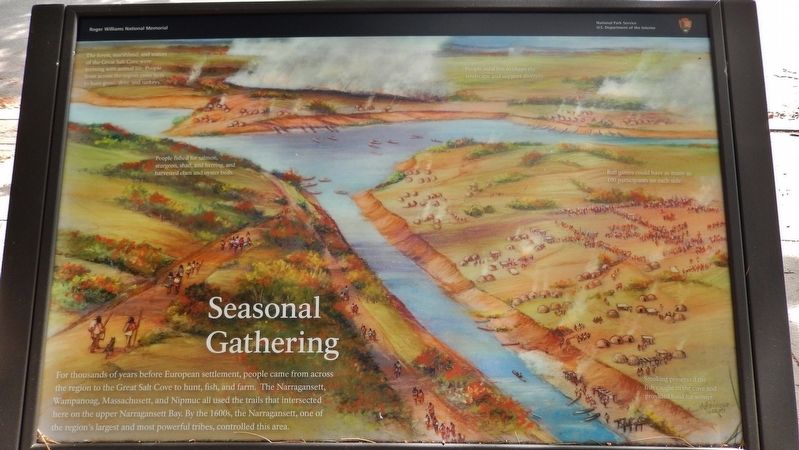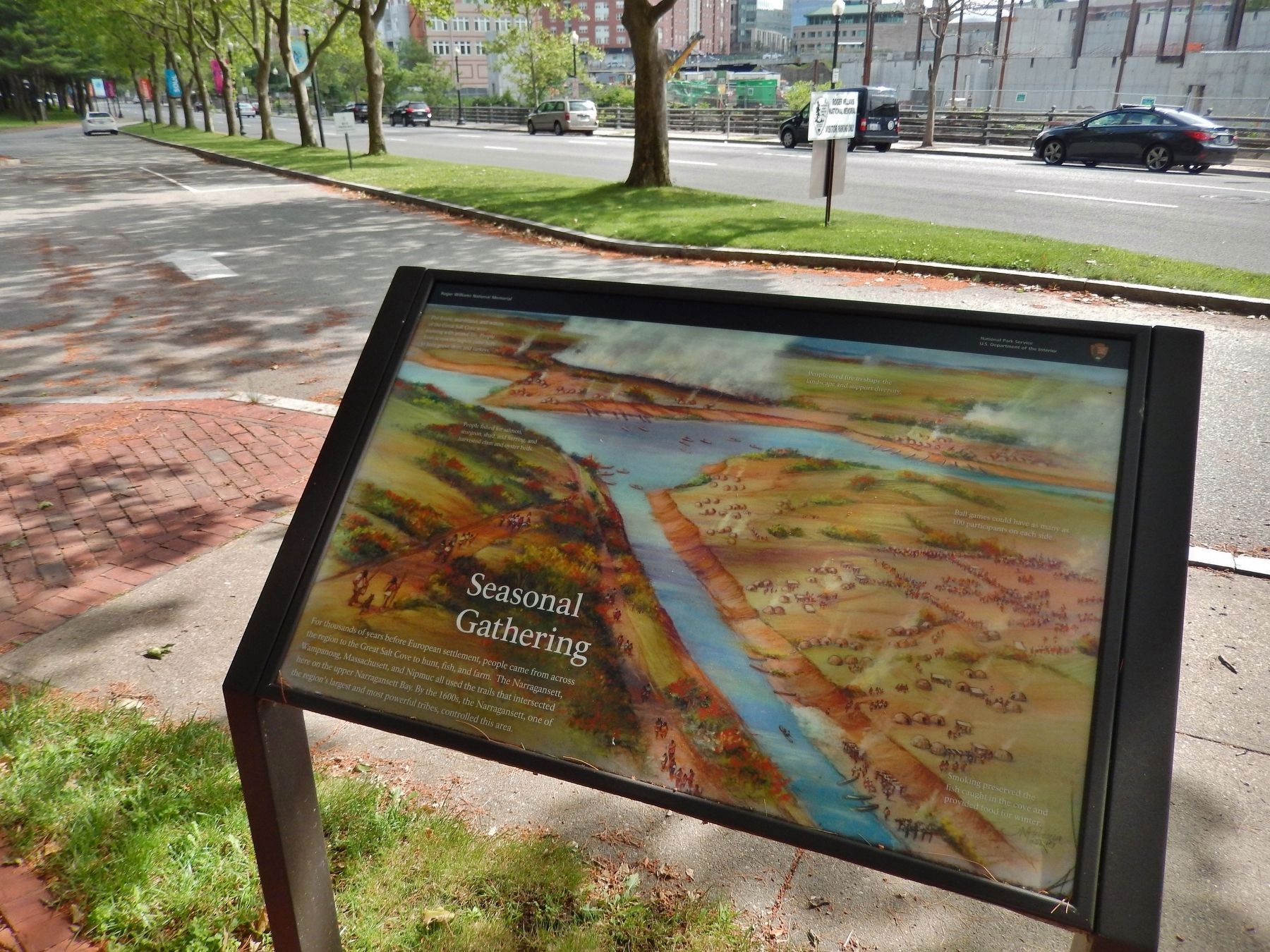Downtown Providence in Providence County, Rhode Island — The American Northeast (New England)
Seasonal Gathering
For thousands of years before European settlement, people came from across the region to the Great Salt Cove to hunt, fish, and farm. The Narragansett, Wampanoag, Massachusett, and Nipmuc all used the trails that intersected here on the upper Narragansett Bay. By the 1600s, the Narragansett, one of the region’s largest and most powerful tribes, controlled this area.
Erected by National Park Service, U.S. Department of the Interior.
Topics. This historical marker is listed in this topic list: Native Americans.
Location. 41° 49.864′ N, 71° 24.664′ W. Marker is in Providence, Rhode Island, in Providence County. It is in Downtown Providence. Marker can be reached from Canal Street south of Smith Street, on the left when traveling south. Marker is within the Roger Williams National Memorial, near Canal Street parking lot entrance. Touch for map. Marker is at or near this postal address: 282 North Main Street, Providence RI 02903, United States of America. Touch for directions.
Other nearby markers. At least 8 other markers are within walking distance of this marker. Gabriel Bernon (within shouting distance of this marker); Snowtown Riot 1831 (within shouting distance of this marker); A Place for Your Ideas (within shouting distance of this marker); Roger Williams National Memorial (within shouting distance of this marker); Witness to History (within shouting distance of this marker); The Cathedral of St. John (within shouting distance of this marker); The Wellspring of Providence (within shouting distance of this marker); A Shelter for Persons Distressed (within shouting distance of this marker). Touch for a list and map of all markers in Providence.
Also see . . .
1. Narragansett People. Wikiepdia entry:
The Narragansett Indian Tribe lived in what is now known as Rhode Island, long before Europeans settled there. The Narraganset and Europeans maintained good relations until King Philip's War in 1675-76. This war was the last major effort by the Indians of southern New England to drive out the English settlers who wanted more and more Indian land. But the Narragansett were completely defeated. After the war, the remaining Narragansetts were forced to live on reservation lands. (Submitted on March 20, 2018, by Cosmos Mariner of Cape Canaveral, Florida.)
2. Wampanoag. Wikipedia entry:
In the beginning of the 17th century, at the time of first contact with the English, the Wampanoag lived in southeastern Massachusetts and Rhode Island. Their population
numbered in the thousands due to the richness of the environment and their cultivation of corn, beans and squash.
The King Philip's War (1675–1676) resulted in the deaths of 40 percent of the surviving tribe. Most of the male Wampanoag were sold into slavery in Bermuda or the West Indies. Many women and children were enslaved by colonists in New England. (Submitted on March 20, 2018, by Cosmos Mariner of Cape Canaveral, Florida.)
3. Massachusett. Wikipedia entry
The Massachusett are a Native American people who historically lived in areas surrounding Massachusetts Bay, as well as northeast and southern Massachusetts in what is now the Commonwealth of Massachusetts, including present-day Greater Boston. As one of the first groups of indigenous American peoples to encounter English colonists, the Massachusett experienced a rapid decline in population in the 17th and 18th centuries due to new infectious diseases. (Submitted on March 20, 2018, by Cosmos Mariner of Cape Canaveral, Florida.)
4. Nipmuc. Wikipedia entry:
The Nipmuc or Nipmuck people are descendants of the indigenous Algonquian peoples of Nippenet, which corresponds to central Massachusetts and immediately adjacent portions of Connecticut and Rhode Island. The tribe were first encountered by Europeans in 1630. The colonists introduced pathogens, such as smallpox, to which the Native Americans had no prior exposure. They were also exposed to alcohol for the first time, which led to huge numbers of natives succumbing to the effects of alcoholism. Then came the passage of increasingly harsh laws against Indian culture and religion, the loss of land, legally and illegally, to growing English colonies. Many of the Nipmuc were interned on Deer Island in Boston Harbor and perished, and others were executed or sold into slavery in the West Indies. (Submitted on March 20, 2018, by Cosmos Mariner of Cape Canaveral, Florida.)
Credits. This page was last revised on February 8, 2023. It was originally submitted on March 20, 2018, by Cosmos Mariner of Cape Canaveral, Florida. This page has been viewed 209 times since then and 16 times this year. Photos: 1, 2. submitted on March 20, 2018, by Cosmos Mariner of Cape Canaveral, Florida. • Andrew Ruppenstein was the editor who published this page.

